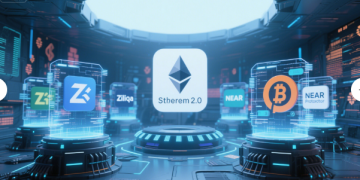Sharding, a transformative technology in blockchain, is reshaping how networks handle transactions, scalability, and security. As the blockchain trilemma—decentralization, security, and scalability—persists, sharding emerges as a critical solution. This article explores the mechanics of sharding, its applications, challenges, and future trends, with a focus on its role in revolutionizing blockchain infrastructure.
Understanding Sharding: How It Works and Why It Matters
Sharding is a database partitioning technique adapted for blockchain networks, dividing data, transactions, and computational tasks into smaller segments called shards . Unlike traditional blockchains where every node processes all transactions, sharding enables parallel processing. Each shard operates independently, handling a subset of transactions, thereby increasing throughput and reducing latency .
For example, Ethereum’s transition to sharding (Ethereum 2.0) aims to boost its transaction capacity from ~30 TPS to over 100,000 TPS by 2025 . This scalability is crucial for supporting decentralized applications (DApps) and DeFi protocols that require high-speed, low-cost transactions.
The Mechanics of Sharding: Breaking Down Blockchain Partitions
Sharding involves three core components: network sharding, state sharding, and transaction sharding .
- Network Sharding: Nodes are divided into shards, each responsible for validating a portion of transactions. Zilliqa, for instance, uses this approach to achieve 2,800 TPS with minimal energy consumption .
- State Sharding: The blockchain’s state (account balances, smart contract data) is split across shards. Ethereum 2.0 plans to implement state sharding to reduce storage requirements and enhance efficiency .
- Transaction Sharding: Transactions are routed to specific shards based on criteria like sender/receiver addresses. This ensures load balancing and prevents bottlenecks .
Key benefits include:
- Scalability: Parallel processing allows networks to handle millions of transactions per second (e.g., NEAR Protocol targets 1 million TPS by 2025 with Nightshade 2.0 ).
- Resource Efficiency: Nodes only store and process a fraction of the data, lowering hardware requirements .
- Decentralization: Reduced entry barriers enable more nodes to participate, strengthening network resilience .

Sharding’s Role in Solving the Blockchain Trilemma
The blockchain trilemma posits that a network cannot optimize decentralization, security, and scalability simultaneously. Sharding disrupts this by distributing workloads while maintaining security through cryptographic proofs and consensus mechanisms like Proof-of-Stake (PoS) .
For example, Ethereum’s move to PoS and sharding reduces energy use by 99% while enhancing security through randomized validator assignments . Similarly, Elrond’s Adaptive State Sharding and Secure Proof-of-Stake (SPoS) ensure fast finality (4–6 seconds) and high throughput (15,000 TPS) .
Challenges and Solutions in Sharding Implementation
Despite its potential, sharding faces significant hurdles:
- Cross-Shard Communication: Coordinating transactions across shards requires robust protocols. Ethereum’s Danksharding (post-2025) aims to improve data availability and cross-shard interactions .
- Security Risks: Compromised shards could threaten network integrity. Zero-Knowledge Proofs (ZK-proofs) and Verifiable Delay Functions (VDFs) are being integrated to enhance security and privacy .
- Fragmentation: Data distribution may complicate audits and analytics. Projects like Radix address this by designing shards to maintain atomic composability .
Innovative solutions include dynamic resharding (NEAR Protocol adjusts shard size based on demand ) and ZK sharding rollups (Nil Foundation’s rollup combines ZK-proofs and sharding for 60,000 TPS ).
Real-World Applications: Sharding in Ethereum 2.0 and Beyond
Ethereum’s sharding roadmap is a pivotal case study. Phase 3 (2025) will enable full transaction processing on shards, while Phase 4 will focus on cross-shard interoperability . Other projects pushing boundaries include:
- Solana: Uses historical hashing and tower BFT to achieve 65,000 TPS .
- Sui: A Layer 1 blockchain with parallel execution and sharding, targeting 120,000 TPS .
- StarkNet: Implements ZK sharding through ZK Threads, enabling scalable DApps with shared liquidity .
The Future of Sharding: Trends and Innovations in 2025
By 2025, sharding will likely become a standard feature in Layer 1 blockchains. Key trends include:
- Hybrid Models: Combining sharding with rollups (e.g., Ethereum’s rollup-centric approach) for exponential scalability .
- AI Integration: Machine learning algorithms optimizing shard allocation and predicting network demand .
- Sustainability: Energy-efficient PoS consensus paired with sharding to reduce environmental impact .
Projects like Radix are also focusing on developer experience, using the Scripto language to simplify sharded DApp development .
Conclusion: Bitora’s Role in Tracking Sharding’s Evolution
As sharding reshapes blockchain infrastructure, platforms like Bitora play a vital role in providing up-to-date insights and analysis. From Ethereum’s 2025 roadmap to NEAR Protocol’s 1 million TPS milestone, Bitora ensures users stay informed about the latest developments in scalability, security, and innovation. Visit Bitora for comprehensive coverage of sharding trends, project updates, and market analysis, empowering you to navigate the decentralized future with confidence.
Stay ahead of the curve with Bitora’s expert insights into blockchain technology and emerging trends.


























